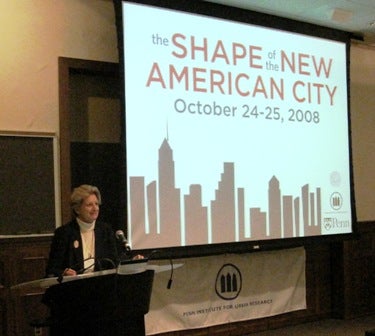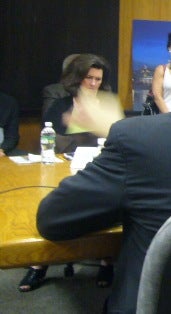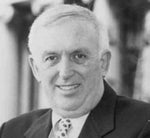“Shape of the New American City”

Oct. 25
MSNBC stars talk city issues and the election at Wharton
Broken economy, say hello to our broken infrastructure: You might hit it off
By Thomas J. Walsh
For PlanPhilly
The shape of the new American city is hard enough to determine in steady economic times. Dichotomies abound. The percentage of the world’s population living in major metropolitan areas is higher than at any time in history. Yet major cities themselves in the United States continue to lose population by the hundreds of thousands. Except, that is, in an increasing number of revitalized downtowns. Politicians, reflecting established policy, romanticize a small-town America that may or may not exist.
“There is no urban policy in the United States,” said Kenneth Jackson, an urban studies expert from Columbia University who weaved historical trends in cities into an overview of current observations. Jackson was one of the opening speakers Friday morning at a conference co-hosted by the Penn Institute for Urban Research and the American Academy of Political and Social Science, entitled “The Shape of the New American City.”
Jackson said that despite this migration to metropolitan areas, critical infrastructure goes unattended, the residual of a century of tax revenues that have steadily moved into federal and state coffers, where the priority was, and is, on roads and subsidizing automotive use. Not only might the Brooklyn Bridge not be built today, Jackson said, but cities have a hard time even affording to paint the bridges they do have.

Barnett
Opening the conference was Camille Cates Barnett, the city of Philadelphia’s managing director. Ten months into her new job, Cates Barnett is at once extremely excited about the city’s possibilities and under siege by the economic circumstances of the moment.
“We have a mayor who said, ‘I’m not interested in managing decline,’” said Barnett, a native of Texas who has worked throughout the country in public policy and financial governance. “That’s one of the reasons I’m here. I was in thrall with the idea of rescuing a city.” But Barnett said she’s been reading histories of Philadelphia, “and I realized that this is a city that’s been reinventing itself for centuries.”
“We’ve got all kinds of new initiatives,” Barnett said. “And then the economy happened.” Speaking of the Philadelphia budget over the past two months, Barnett said she’s been witnessing something she has never seen in her career. “What happened is that once our revenues started to slide … they didn’t quit sliding, and the drop-off in revenues in September and October is unprecedented.”
To hear Jackson immediately following Barnett was striking, because many of the paradoxes that have plagued big cities since World War II are playing out as we speak. Though there is much good news regarding in-fill and the arrival of young singles with good jobs and debt-free empty-nesters in Center City, the wealth of the region is still concentrated in the suburbs.
Barnett was unmistakably saddened to say that budget cuts were a short-term must, but also said there could be an opportunity. “We’re getting ready next week to announce some really tough news about measures we need to take,” she said. “I’m going to look at it as an opportunity to do some things that should’ve been done earlier, but we didn’t have the burning platform for. Well, now we have the burning platform.”
Barnett didn’t elaborate, but Jackson said it was an example of what cities are still up against. Yet, “the economic crisis, which obviously is going to be very severe, need not be disastrous for American cities.” That thought might be described as macroeconomic as well as another example of American urban dichotomies. “Prosperity in the country does not translate necessarily into prosperity for cities.”

Jackson
He cited Philadelphia, Detroit, Cleveland, Pittsburgh and other centers of industry that began to decline in the post-World War II years, which were financially booming times overall for the nation. Compare them to Dresden and other bombed-out European cities, which re-built themselves. American cities used to have excellent public transportation and their downtown public schools enjoyed worldwide prestige. But the phenomenon of the suburbs produced such dramatic population decline – Cleveland went from 900,000 people to 500,000, and Buffalo dropped from 600,000 to 250,000, to cite just two – that “you almost don’t need to look at the other indices,” Jackson said.
“Cities have lost their financial leverage,” he said. A century ago, the budget of New York City was larger than pretty much all of the East Coast states combined. “So again, let’s feel sorry for Camille Barnett, because she has to go back to her office and cut the budget, when the last thing that Philadelphia needs is to have its budget cut.”
Jackson delved into issues of crime (an area with some surprisingly positive trends that cities can try to replicate), deindustrialization, public-private partnerships, examples of rebuilt American versions of Dresden (notably The Bronx and parts of Brooklyn), race and the legalization and normalization of immigration.
There’s a long way to go. One example of many goals to shoot for that Jackson mentioned was this: “An urban renaissance is not complete until a married couple with kids who can’t afford private schools choose to live in the city, and not move to the suburbs,” he said. “For the most part that has not yet happened.”
The conference continues through early Friday evening and concludes Saturday morning with a panel on federal urban policy.
In concluding her remarks Friday morning, Barnett said, “It’s striking to me how little public attention is paid to urban issues. I hope there are events like this all over that will help us. I welcome you as fellow explorers” in this journey to better the health of cities.
“Enjoy Philadelphia,” she said, citing its walkability and other attributes. “And if you really like it, spend a lot of money. Because we need it.”
Contact the reporter at thomaswalsh1@gmail.com
WHYY is your source for fact-based, in-depth journalism and information. As a nonprofit organization, we rely on financial support from readers like you. Please give today.






